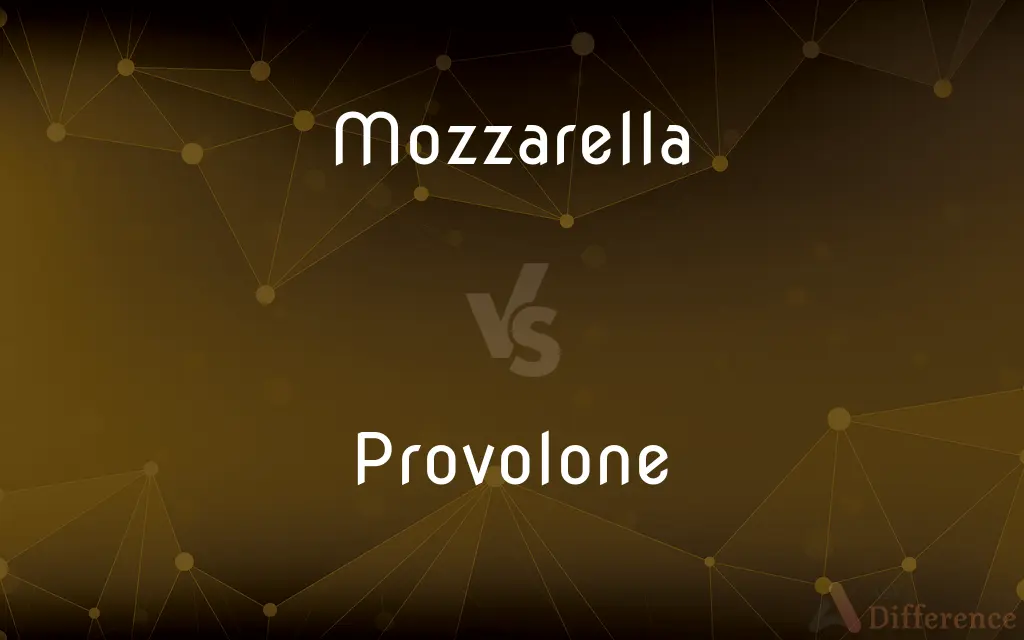Mozzarella vs. Provolone — What's the Difference?
Edited by Tayyaba Rehman — By Urooj Arif — Published on March 28, 2024
Mozzarella is a soft, moist cheese known for its mild flavor and meltability, ideal for pizzas. Provolone is semi-hard, aged longer, with a sharper taste, used in sandwiches and grating.

Difference Between Mozzarella and Provolone
Table of Contents
ADVERTISEMENT
Key Differences
Mozzarella cheese, originating from Italy, is celebrated for its delicate, milky taste and exceptional melting qualities, making it a favorite topping for pizzas and lasagnas. Provolone, also Italian, offers a more pronounced flavor, ranging from slightly piquant to sharp, depending on its aging, and is often found in sandwiches and as a grating cheese over dishes.
The texture of Mozzarella is typically soft and moist, especially when fresh (fior di latte) or made from buffalo milk (mozzarella di bufala). Provolone, in contrast, has a firmer texture, classified as semi-hard, which becomes more pronounced as it ages, enhancing its slicing and grating capabilities.
Mozzarella is best enjoyed fresh, often served within a few days of production to savor its mild and creamy essence. Provolone undergoes a longer aging process, from a few months to over a year, which develops its deeper, more complex flavors, making it suitable for a broader range of culinary applications beyond melting.
The production process of Mozzarella involves the pasta filata method, where the cheese curd is heated and stretched, contributing to its signature texture. Provolone is also produced using a similar technique but is then aged in a controlled environment, which alters its texture and intensifies its taste.
In culinary uses, Mozzarella is the go-to cheese for enhancing the gooey, stretchy quality desired in dishes like pizza and caprese salads. Provolone's versatility shines in both cold and cooked dishes, offering a robust flavor profile that complements meats and vegetables, making it a versatile ingredient in kitchens.
ADVERTISEMENT
Comparison Chart
Texture
Soft and moist
Semi-hard and firmer
Flavor
Mild and milky
Slightly piquant to sharp
Aging Process
Consumed fresh, minimal aging
Aged longer, from months to over a year
Culinary Uses
Ideal for pizzas, lasagnas, and salads
Used in sandwiches, grating over dishes
Production Method
Pasta filata, heated and stretched
Pasta filata, aged in controlled conditions
Compare with Definitions
Mozzarella
A soft, white cheese with a mild flavor.
Mozzarella is the primary cheese on most pizzas.
Provolone
A semi-hard Italian cheese with a sharp taste.
Provolone adds a flavorful punch to sandwiches.
Mozzarella
Minimal aging required.
Fresh mozzarella is best enjoyed within days of production.
Provolone
Aged longer for deeper flavor.
Aged provolone is excellent for grating over pasta dishes.
Mozzarella
Often consumed fresh.
Fresh mozzarella pairs well with tomatoes and basil in a caprese salad.
Provolone
Firmer texture suitable for slicing.
Sliced provolone is a staple in Italian subs.
Mozzarella
Known for its melting qualities.
She topped the lasagna with mozzarella for a gooey texture.
Provolone
Can range from mild to very sharp.
The sharpness of provolone varies with its aging process.
Mozzarella
Made from cow or buffalo milk.
Mozzarella di bufala is prized for its rich, creamy taste.
Provolone
Versatile in cooking, beyond melting.
Provolone complements the flavors in baked casseroles.
Mozzarella
A mild white Italian cheese that has a springy texture and is often eaten melted, as on pizza.
Provolone
A semihard, white or pale yellow Italian cheese, made from cow's milk and often smoked.
Mozzarella
Soft Italian cheese made from cow's or buffalo's milk and commonly used as a pizza topping and in salads etc.
Provolone
A semi-hard cheese made of whole milk from cows. It comes primarily from Southern Italy.
Mozzarella
Mild white Italian cheese
Common Curiosities
Can Mozzarella and Provolone be used interchangeably?
While they can sometimes be substituted for each other, their distinct textures and flavors lend themselves to different culinary uses.
What dishes are best suited for Provolone?
Provolone's bold flavor enhances sandwiches, casseroles, and can be grated over dishes for added depth.
What is Provolone cheese?
A semi-hard Italian cheese, aged longer than mozzarella, known for its sharper taste.
Why is Mozzarella preferred on pizza?
Its soft texture and mild flavor melt perfectly, complementing the tomato sauce and dough without overpowering other toppings.
How should fresh Mozzarella be stored?
Fresh Mozzarella should be kept in its brine or water and consumed within a few days of purchase for the best taste.
What is Mozzarella cheese?
A soft, white Italian cheese known for its mild flavor and excellent melting properties.
Does Provolone melt as well as Mozzarella?
Provolone melts well but doesn't achieve the same level of gooeyness as Mozzarella, making it less ideal for certain dishes like pizza.
How does the aging process affect the flavor of these cheeses?
Longer aging imparts a sharper, more complex flavor to Provolone, while Mozzarella is enjoyed for its fresh, mild taste.
Can lactose intolerant individuals consume these cheeses?
Aged cheeses like Provolone contain less lactose and might be easier to digest, but sensitivity varies by individual.
What makes Provolone cheese unique?
Its aging process, which can range from a few months to over a year, develops a depth of flavor and firmer texture ideal for slicing and grating.
Is Mozzarella always made from buffalo milk?
No, it can be made from cow's milk (fior di latte) or buffalo milk (mozzarella di bufala), with the latter being richer and creamier.
How do these cheeses contribute to Italian cuisine?
They embody the versatility of Italian cheese-making, with Mozzarella enhancing light, fresh dishes and Provolone offering depth to more savory recipes.
Why might someone choose Provolone over Mozzarella?
Preference for Provolone might stem from its firmer texture and bolder flavor, suitable for more robust dishes.
Are there health differences between Mozzarella and Provolone?
Both cheeses provide calcium and protein, but their fat and sodium content can vary, especially between low-moisture and whole milk varieties.
What is the best way to enjoy fresh Mozzarella?
Fresh Mozzarella is best enjoyed at room temperature, allowing its flavors and textures to be fully appreciated.
Share Your Discovery

Previous Comparison
Red Muscle vs. White Muscle
Next Comparison
Method Overloading vs. Method OverridingAuthor Spotlight
Written by
Urooj ArifUrooj is a skilled content writer at Ask Difference, known for her exceptional ability to simplify complex topics into engaging and informative content. With a passion for research and a flair for clear, concise writing, she consistently delivers articles that resonate with our diverse audience.
Edited by
Tayyaba RehmanTayyaba Rehman is a distinguished writer, currently serving as a primary contributor to askdifference.com. As a researcher in semantics and etymology, Tayyaba's passion for the complexity of languages and their distinctions has found a perfect home on the platform. Tayyaba delves into the intricacies of language, distinguishing between commonly confused words and phrases, thereby providing clarity for readers worldwide.
















































